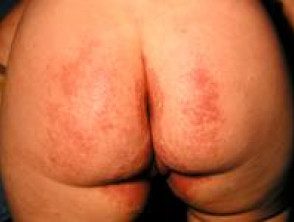What is the napkin? dermatitis?
dermatitis napkin and diaper eruption are used to describe various skin conditions that affect the skin under a baby's napkin. The American term is diaper rash. Napkin dermatitis is usually a form of contact dermatitis.
Who gets napkin dermatitis?
Napkin dermatitis most often affects infants 3 to 15 months of age, especially those using traditional cloth diapers (50%). Is much less predominant in babies with modern, breathable, multi-layer disposable diapers.
Napkin dermatitis can also affect older children and adults who are incontinent (incontinence-associated dermatitis).
What is the cause of napkin dermatitis?
Napkin dermatitis follows damage to the normal skin barrier and is primarily a form of irritating contact dermatitis.
- urine and occlusion lead to overhydration and skin maceration.
- fecal bile salts and enzymes breakdown stratum corneum lipids and proteins.
- A mixture of urine and feces creates ammonium hydroxide, raising pH.
- Moist skin is colonized by micro-organisms, particularly candida.
- Mechanical friction from limb movement can increase discomfort.
- Pre-existing skin conditions such as atopic dermatitis or seborrheic dermatitis predispose a baby to napkin dermatitis.
Babies who are breastfed have less incidence of napkin dermatitis, since stool in breastfed babies has a lower pH than in formula-fed babies. As babies begin to eat solid food, stool frequency and pH begin to increase and napkin dermatitis occurs more frequently.
Other causes of napkin rashes include:
- Candida albicans
- Impetigo
- Childish seborrheic dermatitis
- Atopic eczema
- Psoriasis
- Miliaria
- Acrodermatitis enteropatica
-
sensitive biotin skin disease
- Rare disorders.
Napkin dermatitis is not due to:
- Allergy to the napkins
- Toxins on the napkins
- Powdered detergents (unless not completely removed by rinsing)
- Dermatophyte fungal infections (ringworm).
What are the clinical features of napkin dermatitis?
Napkin dermatitis presents as erythematous macules and papules in the genital area that can spread to involve the lower abdomen and thighs.
- Irritant napkin dermatitis: well-demarcated variable erythema, edema, dryness and climbing. The affected skin is in contact with the moist napkin and tends to avoid skin folds.
- Frictions: erythema and erosions where the napkin rubs, usually on the waist or thighs.
- Granuloma gluteale infantum: red or purple nodules
- Candida albicans: erythematous papules and plates with small satellite or surface spots pustules.
-
ImpetigoStaphylococcus aureus and Streptococcus pyogenes): blisters and irregular pustules.
- Infantile seborrheic dermatitis: cradle and bilateral Salmon pink, often scaly patches in skin folds.
-
Atopic dermatitis: Bilateral scratching, dry patches anywhere but uncommon in diaper area, and family history common.
-
Psoriasis: persistent, well-circumscribed, symmetricalbright red, scaly or macerated plates; other sites may be involved; common family history.
- Disseminated secondary eczema or autoeczematization: rash on distal sites associated with severe napkin rash.
Napkin dermatitis can predispose the baby to the urinary tract infection and in women, to vaginal infection.
Napkin dermatitis

Napkin dermatitis

thrush dermatitis napkin

Napkin dermatitis
See more images of napkin dermatitis.
What tests should be done?
In most cases, no laboratory tests are needed. Skin swabs may be helpful in confirming Candida albicans or bacterial infection.
What is the treatment for napkin dermatitis?
General measures
The need to keep the baby dry and to use barrier creams should be emphasized. The caregiver should always wash their hands before and after changing a diaper/nappy. Napkin dermatitis is much less common with modern disposable napkins than with cloth diapers.
Disposable diapers:
- They are available in different shapes and sizes depending on age and sex
- It can be selected in a larger size to reduce contact and friction between the napkin and the skin.
- Keep skin dry and clean.
- Maintain the optimal pH of the skin.
- Must be changed when wet or dirty
- Contains cellulose pulp and superabsorbent polymers.
- May include Vaseline-based hydration lotion to support the skin barrier
- Fasteners, backsheets and stretch reduce leaks.
- are nottoxic and biologically inert
- It does not have Allergens such as natural rubber latex or disperse dyes
- It leads to less household exposure to fecal matter.
If you use cloth diapers, use diaper liners to keep skin dry. Avoid plastic pants.
For napkin changes:
- Gently clean baby's skin with water and a soft cloth.
- Wet wipes are convenient but expensive and can cause contact allergy to preservatives used to prevent mold
- Aqueous cream or other non-soap cleanser can be used if needed
- Pat dry gently and let air dry
- Apply a protectant emollient ointment containing petrolatum and zinc oxide.
Other suggestions
- Give fluids early in the evening to reduce wetness at night.
- Note whether certain foods are linked to the rash by increasing the acidity of the stool (eg, orange juice) or the frequency. If this is the case, stop responsible eating, at least temporarily.
- Allow times without diapers.
prescription treatments
- Mild current steroids such as hydrocortisone cream applied to inflamed skin once or twice a day for 1 to 2 weeks.
-
Topical antifungal cream (eg, clotrimazole, ketoconazole, ciclopirox, sertaconazole) once or twice daily if you suspect Candida albicans infection.
- Strong steroid creams should not be applied to the baby's bottom, due to possible side effects of stretch marks, tachyphylaxis, and skin thinning.
- Over-the-counter topical products containing aloe vera and calendula officinalis They are reportedly effective for napkin dermatitis.

